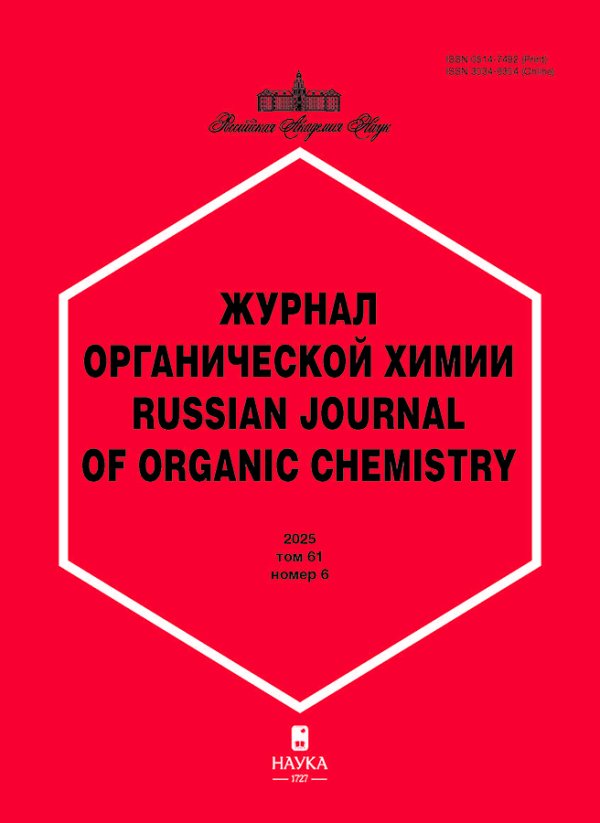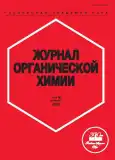Mass Spectra of New Heterocycles: XXVI. Electron Impact and Chemical Ionization Study of N-[5-Amino-2-thienyl]- and N-[2-(Methylsulfanyl)-1,3-thiazol-5-yl]isothioureas
- Authors: Klyba L.V1, Sanzheeva E.R1, Nedolya N.A1, Tarasova O.A1
-
Affiliations:
- Favorsky Irkutsk Institute of Chemistry, Siberian Branch, Russian Academy of Sciences
- Issue: Vol 59, No 7 (2023)
- Pages: 895-903
- Section: Articles
- URL: https://journals.rcsi.science/0514-7492/article/view/141657
- DOI: https://doi.org/10.31857/S0514749223070030
- EDN: https://elibrary.ru/HSFRXX
- ID: 141657
Cite item
Full Text
Abstract
About the authors
L. V Klyba
Favorsky Irkutsk Institute of Chemistry, Siberian Branch, Russian Academy of Sciences
Email: klyba@irioch.irk.ru
E. R Sanzheeva
Favorsky Irkutsk Institute of Chemistry, Siberian Branch, Russian Academy of Sciences
N. A Nedolya
Favorsky Irkutsk Institute of Chemistry, Siberian Branch, Russian Academy of Sciences
O. A Tarasova
Favorsky Irkutsk Institute of Chemistry, Siberian Branch, Russian Academy of Sciences
References
- Клыба Л.В., Санжеева Е.Р., Недоля Н.А., Тарасова О.А. ЖОрХ. 2023, 58, 596-602.
- Klyba L.V., Sanzheeva E.R., Nedolya N.A., Tarasova O.A. Russ. J. Org. Chem. 2023, 58, 776-781. doi: 10.1134/S1070428023050056
- Steppeler F., Iwan D., Wojaczyńska E., Wojaczyński J. Molecules. 2020, 25, 401. doi: 10.3390/molecules25020401
- Shakeel A., Altaf A.A., Qureshi A.M., Badshah A. J. Drug Des. Med. Chem. 2016, 2, 10-20. doi: 10.11648/j.jddmc.20160201.12
- Khan E., Khan S., Gul Z., Muhammad M. Critical Rev. Analyt. Chem. 2021, 51, 812-834. doi: 10.1080/10408347.2020.1777523
- Saeed A., Mustafa M.N., Zain-Ul-Abideen M., Shabir G., Erben M.F., Flörke U. J. Sulfur Chem. 2019, 40, 312-350. doi: 10.1080/17415993.2018.1551488
- Goncalves I.L., de Azambuja G.O., Kawano D.F., Eifler-Lima V.L. Mini. Rev. Org. Chem. 2018, 15, 28-35. doi: 10.2174/157019314666170518125219
- Li J., Shi L.-L., Chen J., Gong J., Yang Z. Synthesis. 2014, 46, 2007-2023. doi: 10.1055/s-0034-1378209
- Biswas A., Mondal H., Maji M.S. J. Heterocycl. Chem. 2020, 57, 3818-3844. doi: 10.1002/jhet.4119
- McLaughlin C., Smith A.D. Chem. Eur. J. 2021, 27, 1533-1555. doi: 10.1002/chem.202002059
- Saeed A., Flörke U., Erben M.F. J. Sulfur Chem. 2014, 35, 318-355. doi: 10.1080/17415993.2013.834904
- Blažek Bregović V., Basarić N., Mlinarić-Majerski K. Coord. Chem. Rev. 2015, 295, 80-124. doi: 10.1016/j.ccr.2015.03.011
- Sulthana M.T., Alagarsamy V., Chitra K. Med. Chem. (Sharjah, United Arab Emirates). 2021, 17, 352-368. doi: 10.2174/1573406416666200817153033
- Ma C., Wu A., Wu Y., Ren X., Cheng M. Archiv Pharm. (Weinheim, Germany). 2013, 346, 891-900. doi: 10.1002/ardp.201300276
- Siddiqui N., Alam M.S., Sahu M., Naim M.J., Yar M.S., Alam O. Bioorg. Chem. 2017, 71, 230-243. doi: 10.1016/j.bioorg.2017.02.009
- Pucko E., Matyja E., Koronkiewicz M., Ostrowski R.P., Kazimierczuk Z. Anticancer Res. 2018, 38, 2691-2705. doi: 10.21873/anticanres.12511
- Narendhar B., Chitra K., Alagarsamy V. Pharm. Chem. J. 2021, 55, 54-59. doi: 10.1007/s11094-021-02371-7
- Sperry J.B., Wright D.L. Curr. Opin. Drug Discov. Devel. 2005, 8, 723-740. doi: 10.1002/chin.200615242
- Handbook of Oligo- and Polythiophenes. Ed. D. Fichou. Weinheim: Wiley-VCH. 1999.
- Gupta V., Kant V. Sci. Int. 2013, 1, 253-260. doi: 10.17311/sciintl.2013.253.260
- Siddiqui N., Arshad M.F., Ahsan W., Alam M.S. Int. J. Pharm. Sci. Drug Res. 2009, 1, 136-143.
- Grehn L. J. Heterocycl. Chem. 1978, 15, 81-87. doi: 10.1002/jhet.5570150118
- McCarthy W.C., Foss L.E. J. Org. Chem. 1977, 42, 1508-1510. doi: 10.1021/jo00429a004
- Al-Omran F., El-Khair A.A. J. Heterocycl. Chem. 2004, 41, 909-914. doi: 10.1002/jhet.5570410610
- Dolzhenko A.V. Heterocycles. 2011, 83, 1489-1525. doi: 10.3987/REV-11-701
- Venkatachalam T.K., Sudbeck E.A., Mao C., Uckun F.M. Bioorg. Med. Chem. Lett. 2001, 11, 523-528. doi: 10.1016/S0960-894X(01)00011-7
- Tarasova O.A., Nedolya N.A., Albanov A.I., Trofimov B.A. ChemistrySelect. 2020, 5, 5726-5731. doi: 10.1002/slct.202000577
- Nedolya N.A. Novel Chemistry Based on Isothiocyanates and Polar Organometallics. PhD Thesis. Utrech University, Netherlands, 1999.
- Клыба Л.В., Санжеева Е.Р., Недоля Н.А., Тарасова О.А. ЖОрХ. 2023, 59, 38-46.
- Klyba L.V., Sanzheeva E.R., Nedolya N.A., Tarasova O.A. Russ. J. Org. Chem. 2023, 59, 62-72. doi: 10.1134/S1070428023010037
Supplementary files










